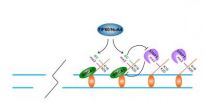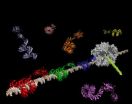(Press-News.org) PHILADELPHIA - Double-strand breaks in DNA happen every time a cell divides and replicates. Depending on the type of cell, that can be pretty often. Many proteins are involved in everyday DNA repair, but if they are mutated, the repair system breaks down and cancer can occur. Cells have two complicated ways to repair these breaks, which can affect the stability of the entire genome.
Roger A. Greenberg, M.D., Ph.D., associate investigator, Abramson Family Cancer Research Institute and associate professor of Cancer Biology at the Perelman School of Medicine, University of Pennsylvania, together with postdoctoral researcher Jiangbo Tang Ph.D. and colleagues, found a key determinant in the balance between two proteins, BRCA1 and 53BP1, in the DNA repair machinery. Breast and ovarian cancer are associated with a breakdown in the repair systems involving these proteins. Their findings appear in the latest online issue of Nature Structural & Molecular Biology.
The two proteins, BRCA1 and 53BP1, control which of two cell-repair mechanisms will be used: homologous recombination or non-homologous end-joining, technically speaking. This competition has proven to be a key factor in determining whether a cell becomes cancer prone as well as how a cancer cell will respond to chemotherapy.
The key step of the balance is acetylation, the chemical process of adding a compound called an acetyl group to other cellular molecules.
The researchers asked what cell signals determine whether BRCA or 53BP1 predominates at a DNA break site.
DNA in the nucleus is tightly packed around proteins called histones. Acetylation at a specific spot on histone H4 determines the answer. If H4 is acetylated at a specific location, then 53BP1 binding near the broken DNA region is strongly reduced. This leaves BRCA1 free to do the work, kicking in the homologous recombination tool to repair the break.
On the other hand, if acetylation is reduced, 53BP1 outcompetes BRCA1 at a break and the non-homologous end-joining tool repairs the break.
This mechanism can help explain resistance to a promising chemotherapy called PARP inhibition seen in patients and mouse models with BRCA1 mutations. Work from several other research teams surprisingly has shown that if neither BRCA nor 53BP1 are available, then the homologous recombination system goes into action even in the absence of BRCA1 and BRCA1 mutant cancer cells become resistant to PARP inhibitors.
Because of this, Greenberg says, there are some possible applications for making PARP chemotherapy more sensitive: "If you could inhibit specific acetylation events, then a patient's response to PARP inhibitors might be enhanced by hyperactivating 53BP1 binding to breaks in the context of BRCA1 deficient cancers. What's more, measuring the levels of acetylation at H4 might predict how responsive an individual is to PARP inhibitors."
"The story didn't fall into place the way we thought it would," says Greenberg. "We didn't realize that it was a combination of two epigenetic marks that drives the repair system. However, we were able to show that 53BP1 doesn't bind well to regions of histone H4 that are acetylated at a specific location on H4. Collaboration with Georges Mer, a structural biologist at the Mayo Clinic, helped provide the molecular basis for these findings. We think there will be further complexity to this regulation, creating the possibility for the discovery of additional mechanisms that regulate DNA repair pathways and response to therapy and potential new targets for diagnosis and therapy."
INFORMATION:
Co-authors are Nam Woo Cho, Erica M. Manion, Niraj M. Shanbhag, all from Penn, and Gaofeng Cui, Maria Victoria Botuyan, and Georges Mer, from the Department of Biochemistry and Molecular Biology, Mayo Clinic.
The research was supported by the National Cancer Institute (1R01CA138835-01, 1R01CA132878, P50CA116201), a Research Scholar Grant from the American Cancer Society, a DOD Breast Cancer Idea Award, a UPENN-FCCC SPORE Pilot Grant, and funds from the Abramson Family Cancer Research Institute and Basser Research Center for BRCA.
Penn Medicine is one of the world's leading academic medical centers, dedicated to the related missions of medical education, biomedical research, and excellence in patient care. Penn Medicine consists of the Raymond and Ruth Perelman School of Medicine at the University of Pennsylvania (founded in 1765 as the nation's first medical school) and the University of Pennsylvania Health System, which together form a $4.3 billion enterprise.
The Perelman School of Medicine is currently ranked #2 in U.S. News & World Report's survey of research-oriented medical schools. The School is consistently among the nation's top recipients of funding from the National Institutes of Health, with $479.3 million awarded in the 2011 fiscal year.
The University of Pennsylvania Health System's patient care facilities include: The Hospital of the University of Pennsylvania -- recognized as one of the nation's top "Honor Roll" hospitals by U.S. News & World Report; Penn Presbyterian Medical Center; and Pennsylvania Hospital — the nation's first hospital, founded in 1751. Penn Medicine also includes additional patient care facilities and services throughout the Philadelphia region.
Penn Medicine is committed to improving lives and health through a variety of community-based programs and activities. In fiscal year 2011, Penn Medicine provided $854 million to benefit our community.
Changes to DNA on-off switches affect cells' ability to repair breaks, respond to chemotherapy
2013-02-04
ELSE PRESS RELEASES FROM THIS DATE:
Researchers discover mutations linked to relapse of childhood leukemia
2013-02-04
After an intensive three-year hunt through the genome, medical researchers have pinpointed mutations that leads to drug resistance and relapse in the most common type of childhood cancer—the first time anyone has linked the disease's reemergence to specific genetic anomalies.
The discovery, co-lead by William L. Carroll, MD, director of NYU Langone Medical Center's Cancer Institute, is reported in a study published online February 3, 2013, in Nature Genetics.
"There has been no progress in curing children who relapse, in spite of giving them very high doses of chemotherapy ...
Pioneering research helps to unravel the brain's vision secrets
2013-02-04
A new study led by scientists at the Universities of York and Bradford has identified the two areas of the brain responsible for our perception of orientation and shape.
Using sophisticated imaging equipment at York Neuroimaging Centre (YNiC), the research found that the two neighbouring areas of the cortex -- each about the size of a 5p coin and known as human visual field maps -- process the different types of visual information independently.
The scientists, from the Department of Psychology at York and the Bradford School of Optometry & Vision Science established ...
Immune cell 'survival' gene key to better myeloma treatments
2013-02-04
Scientists have identified the gene essential for survival of antibody-producing cells, a finding that could lead to better treatments for diseases where these cells are out of control, such as myeloma and chronic immune disorders.
The discovery that a gene called Mcl-1 is critical for keeping this vital immune cell population alive was made by researchers at Melbourne's Walter and Eliza Hall Institute. Associate Professor David Tarlinton, Dr Victor Peperzak and Dr Ingela Vikstrom from the institute's Immunology division led the research, which was published today in ...
Growth factor aids stem cell regeneration after radiation damage
2013-02-04
DURHAM, N.C. – Epidermal growth factor has been found to speed the recovery of blood-making stem cells after exposure to radiation, according to Duke Medicine researchers. The finding could open new options for treating cancer patients and victims of dirty bombs or nuclear disasters.
Reported in the Feb. 3, 2013, issue of the journal Nature Medicine, the researchers explored what had first appeared to be an anomaly among certain genetically modified mice with an abundance of epidermal growth factor in their bone marrow. The mice were protected from radiation damage, and ...
Recreating natural complex gene regulation
2013-02-04
DURHAM, N.C. – By reproducing in the laboratory the complex interactions that cause human genes to turn on inside cells, Duke University bioengineers have created a system they believe can benefit gene therapy research and the burgeoning field of synthetic biology.
This new approach should help basic scientists as they tease out the effects of "turning on" or "turning off" many different genes, as well as clinicians seeking to develop new gene-based therapies for human disease.
"We know that human genes are not just turned on or off, but can be activated to any level ...
Plant scientists at CSHL demonstrate new means of boosting maize yields
2013-02-04
Cold Spring Harbor, NY – A team of plant geneticists at Cold Spring Harbor Laboratory (CSHL) has successfully demonstrated what it describes as a "simple hypothesis" for making significant increases in yields for the maize plant.
Called corn by most people in North America, modern variants of the Zea mays plant are among the indispensable food crops that feed billions of the planet's people. As global population soars beyond 6 billion and heads for an estimated 8 to 9 billion by mid-century, efforts to boost yields of essential food crops takes on ever greater potential ...
Poor mental health leads to unhealthy behaviors among low-income adults
2013-02-04
Poor mental health leads to unhealthy behaviors in low-income adults – not the other way around, according to a new study¹ by Dr. Jennifer Walsh and colleagues from the Centers for Behavioral and Preventive Medicine at The Miriam Hospital in the US. In this study, stress and anxiety predicted subsequent health-compromising behaviors, such as smoking, binge drinking, illegal drug use, unprotected sex and unhealthy diets. One possible explanation for these findings is that health compromising behaviors may be used as coping mechanisms to manage the effects of stress and anxiety. ...
Monell scientists identify elusive taste stem cells
2013-02-04
PHILADELPHIA (February 4, 2013) – Scientists at the Monell Center have identified the location and certain genetic characteristics of taste stem cells on the tongue. The findings will facilitate techniques to grow and manipulate new functional taste cells for both clinical and research purposes.
"Cancer patients who have taste loss following radiation to the head and neck and elderly individuals with diminished taste function are just two populations who could benefit from the ability to activate adult taste stem cells," said Robert Margolskee, M.D., Ph.D., a molecular ...
Geographic factors can cause allergies, asthma
2013-02-04
ARLINGTON HEIGHTS, Ill. (February 4, 2013) – Those living near the equator may find themselves sneezing and wheezing more than usual. And the reason may not be due to increasing pollen counts. According to a new study released today, in the February issue of Annals of Allergy, Asthma & Immunology, the scientific journal of the American College of Allergy, Asthma and Immunology (ACAAI), living in locations closest to the equator can put you at increased risk of developing allergy and asthma.
"UV-B rays exposure is higher for people living in areas closer to the equator," ...
Yellowfin 24 Bay Boat Review
2013-02-04
By Capt. Shafter Johnston
I had the chance to fish a Yellowfin 24 Bay boat for a couple days in the everglades. The boat was outfitted with a 300 Mercury Verado, twin 10 foot PowerPole Blades, a 101 lb thrust Minn Kota trolling motor, and Simrad electronics.
I have fished and guided out of quite a few diferent bay boat models bulit by several different companies but I have to say that this was the most impressive by far.
Aside from its killer looks the boat performs flawlessly. The boat is incredibly fast when neccessary but more important to me and most guides ...

